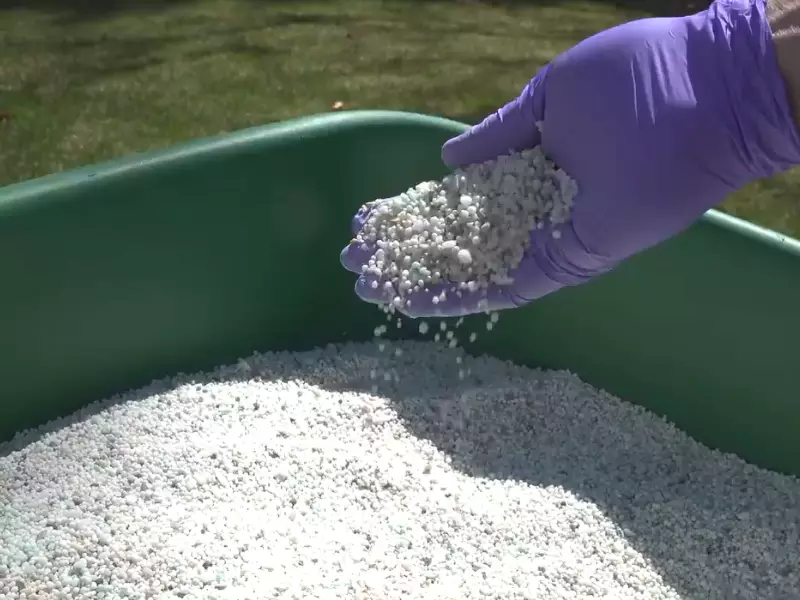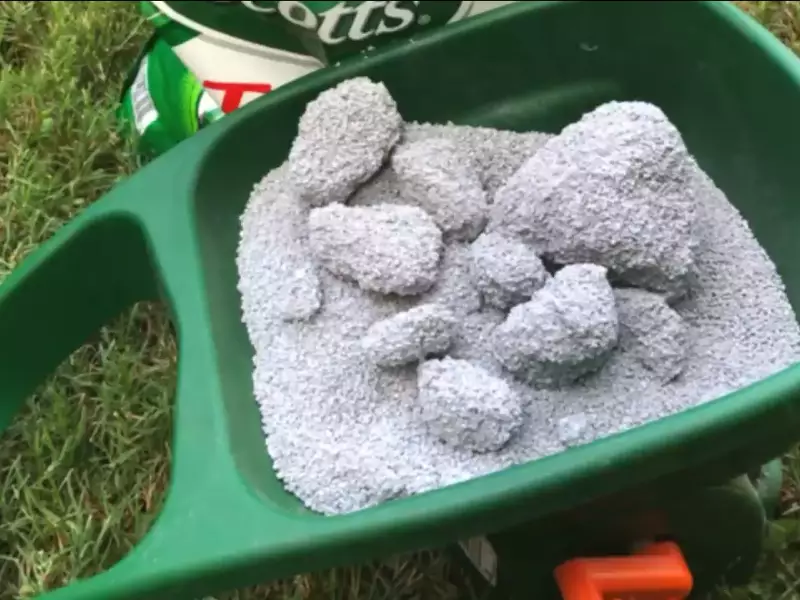Lawn care is an essential aspect of homeownership, and while fertilizing our gardens can lead to lush green landscapes, concerns arise when we consider the effects of these fertilizers on well water sources.
Most homes rely on well water as a primary source of drinking water, and its quality and safety are of paramount importance. Fertilizers, if not used judiciously, can pose significant risks to the purity of this water.
Lawn Fertilizers: The Basics
Composition and Main Ingredients
Lawn fertilizers are formulated to provide essential nutrients that plants might not readily get from natural soil. The three primary nutrients are nitrogen (N), phosphorus (P), and potassium (K). Each of these plays a distinct role:

- Nitrogen (N): This is primarily responsible for promoting green, leafy growth. It’s a crucial component of chlorophyll, the compound plants use to convert sunlight into energy during photosynthesis.
- Phosphorus (P): Vital for root development, phosphorus helps plants establish a strong foundational system. This nutrient also aids in flower and fruit production, making it crucial for flowering plants and fruit trees.
- Potassium (K): Often referred to as the “protector” nutrient, potassium strengthens plants, enabling them to withstand various stresses like drought, diseases, and pests. It also plays a role in various plant processes, including photosynthesis and enzyme activation.
How They Work on Plants
Once applied, these granular or liquid fertilizers seep into the soil. The nutrients dissolve in the soil’s moisture, making them accessible to plant roots. As plants grow, they draw up these nutrients, which play a vital role in their overall health and vitality. Fertilizers can be fast-acting or slow-release. While fast-acting fertilizers provide immediate nutrition, slow-release variants provide sustained nutrition over a more extended period, reducing the need for frequent application.
Well Water and Its Vulnerability
What is Well Water and How is It Sourced?
Well water is groundwater collected from aquifers, which are permeable rocks that can contain or transmit groundwater. An aquifer fills with water from rain or melted snow that drains into the ground. This water can be decades old and, in some cases, even centuries. A well is essentially a system that taps into these aquifers, drawing up water for household or agricultural use.
Factors Affecting Well Water Contamination
Several factors determine the susceptibility of well water to contamination:
- Depth of the Well: Shallow wells are generally more vulnerable than deeper ones as contaminants don’t need to seep down as far.
- Age and Construction of the Well: Older wells, especially those without proper casing or liners, are at a higher risk.
- Location: Wells situated near agricultural lands, septic systems, or industrial areas face more contamination risks due to closer proximity to pollutants.

Effects of Lawn Fertilizers on Well Water
How Fertilizers Reach Groundwater
Water that doesn’t get absorbed by the soil carries away surface materials, such as fertilizer residues, in its flow. This movement, known as runoff, can deposit these residues directly into water bodies or groundwater sources. Leaching, on the other hand, refers to the vertical movement of water through soil, taking with it dissolved nutrients like those from fertilizers. This process can introduce these nutrients into deeper groundwater, affecting well water sources.
Chemical Composition Changes in Water After Fertilizer Contamination
A crucial concern with fertilizer runoff is the introduction of high nitrate levels into the water. When consumed in large amounts, nitrates can have detrimental health effects. Additionally, an influx of nutrients like phosphorus can lead to eutrophication, where excessive nutrient levels cause rapid algal growth. As these algae die and decompose, they use up oxygen in the water, harming fish and other aquatic organisms due to oxygen depletion.
Hazards of Contaminated Well Water
Health Implications of Consuming Contaminated Water
Beyond the risks of nitrate consumption, which can lead to conditions like blue baby syndrome in infants, other contaminants from fertilizers can have varied health effects. For instance, some fertilizers might contain heavy metals, which, if ingested in large amounts, can lead to poisoning and long-term health complications.
Harm to Aquatic Life and Ecosystem Balance
Eutrophication, spurred by an overload of nutrients from fertilizers, doesn’t just deplete oxygen levels. The resulting algal blooms can release toxins harmful to aquatic life. Furthermore, these rapid changes in water composition can disrupt the balance of ecosystems, leading to a decrease in biodiversity.

Safe Fertilization Practices
Best Seasons and Times
Timing your fertilizer application can significantly reduce the risk of contamination. The growing season, when plants are actively absorbing nutrients, is the most effective time for fertilization. Avoiding application before heavy rainfalls is crucial as this is when the risk of runoff is at its peak.
Correct Quantity: Avoiding Over-fertilization
It’s tempting to believe that more fertilizer will lead to healthier plants, but over-fertilization can harm both your garden and the environment.
- Soil Testing: Before applying fertilizers, consider conducting a soil test. This test will provide a detailed analysis of the nutrients your soil already contains, allowing you to add only what’s necessary.
Alternatives to Traditional Fertilizers
Organic and Natural Fertilizers: Benefits and Effectiveness
Unlike synthetic fertilizers, organic variants derive from natural sources. They release nutrients more slowly, ensuring a steady supply over a prolonged period, and significantly reduce the risk of leaching and runoff.
Composting: Using Homemade Solutions
Compost, created by decomposing organic matter, is rich in nutrients and beneficial microbes. Incorporating compost not only feeds the soil but also enhances its structure and water retention capacity.
Grass-cycling: Leaving Grass Clippings on the Lawn
When mowing your lawn, leave the clippings behind. As they decompose, they return valuable nutrients to the soil, reducing the need for additional fertilizers.
Protecting Well Water from Contamination
Proper Well Maintenance: Sealing and Regular Check-ups
A well-maintained well is your first defense against contamination. Proper sealing prevents surface contaminants from entering, while regular inspections ensure the structural integrity of the well.
Creating Barriers: Planting Buffer Zones Around the Well
A buffer zone, comprising specific vegetation types, acts as a filter. It traps potential contaminants, ensuring they don’t reach the well.
Landscape Design: Contouring the Lawn for Reduced Runoff
A well-thought-out landscape can direct water flow, ensuring it’s steered away from sensitive areas like wells. Incorporating features like swales and rain gardens can capture runoff, allowing it to be absorbed slowly, reducing contamination risks.
Frequently Asked Questions
What are the signs of well water contamination?
Visible signs include changes in water taste, odor, and color. Additionally, gastrointestinal issues in inhabitants could indicate contamination.
How often should I test my well water?
It’s advisable to test well water annually for nitrates, total coliform bacteria, pH levels, and other contaminants.
Can I purify contaminated well water?
Yes, several purification methods are available, including reverse osmosis, distillation, and carbon filters. It’s crucial to identify the specific contaminants before choosing a purification method.
Conclusion
Protecting the purity of well water while maintaining a thriving lawn is not just feasible, but necessary. As homeowners, our choices directly impact the environment and our health.
Adopting mindful gardening practices and ensuring regular maintenance of our wells can strike a harmonious balance between nature and nurture. With diligence and awareness, our gardens can flourish without compromising the safety of our essential water sources.